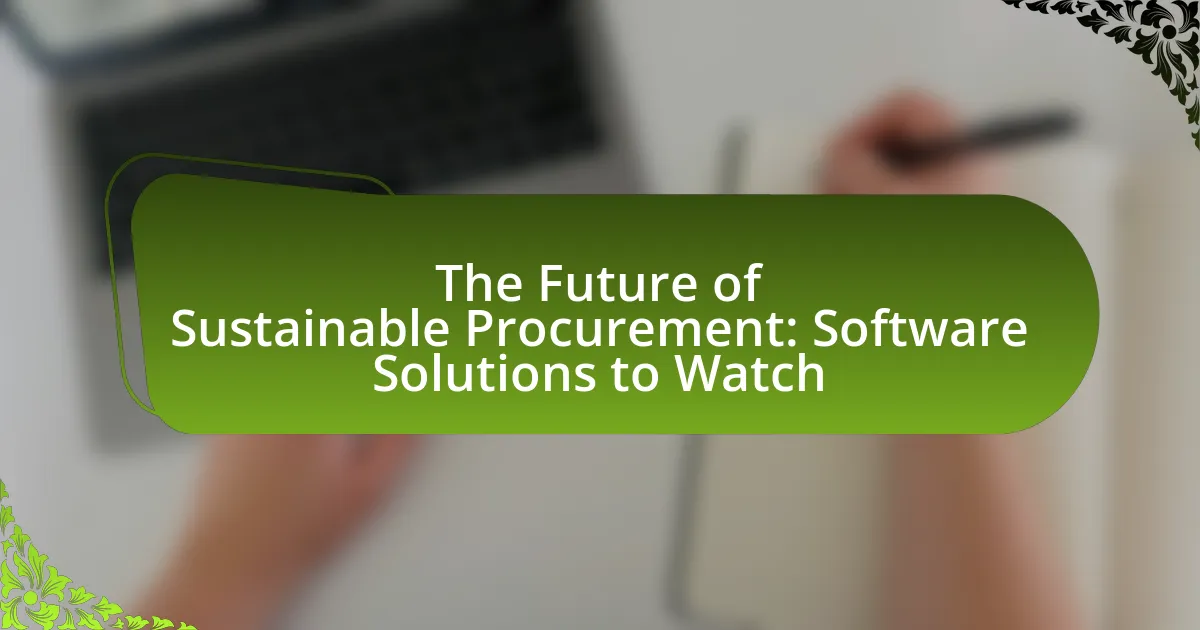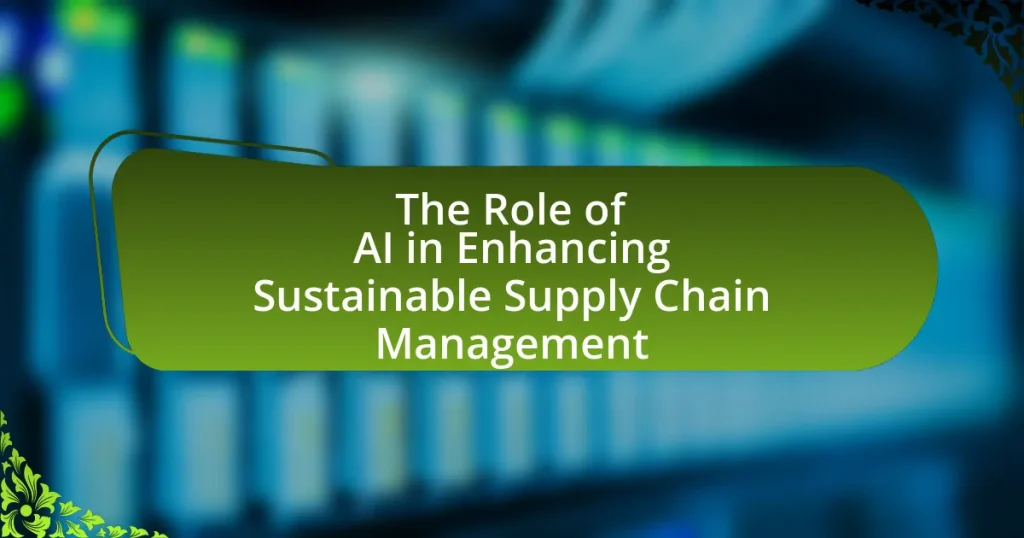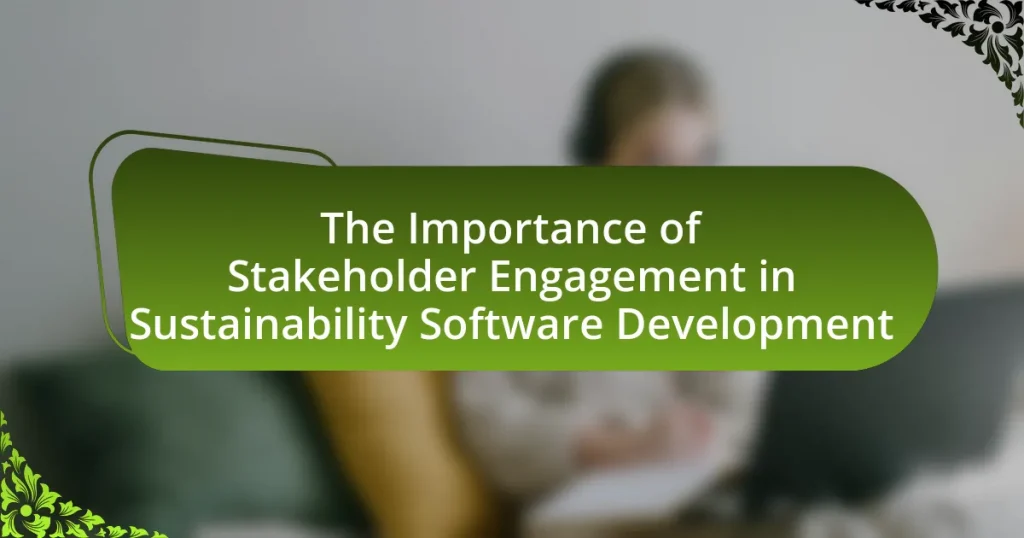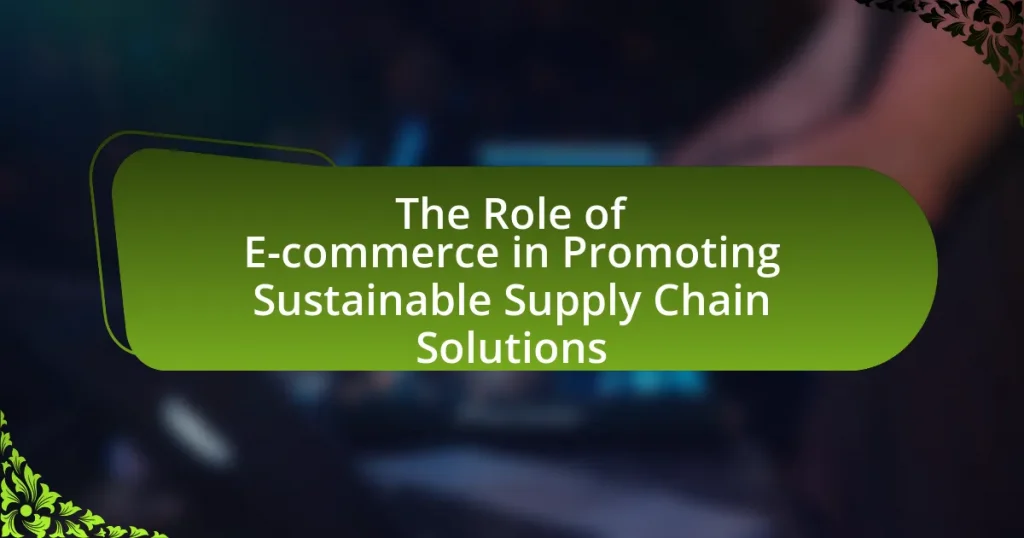Sustainable procurement is the practice of acquiring goods and services while considering their environmental, social, and economic impacts. This article explores the significance of sustainable procurement, highlighting its differences from traditional procurement methods, key principles, and the role of technology in enhancing sustainability outcomes. It discusses emerging software solutions that facilitate sustainable practices, the benefits of these tools, and the challenges organizations face in their implementation. Additionally, the article outlines best practices for successful adoption and continuous improvement in sustainable procurement processes, emphasizing the importance of stakeholder engagement and effective training.
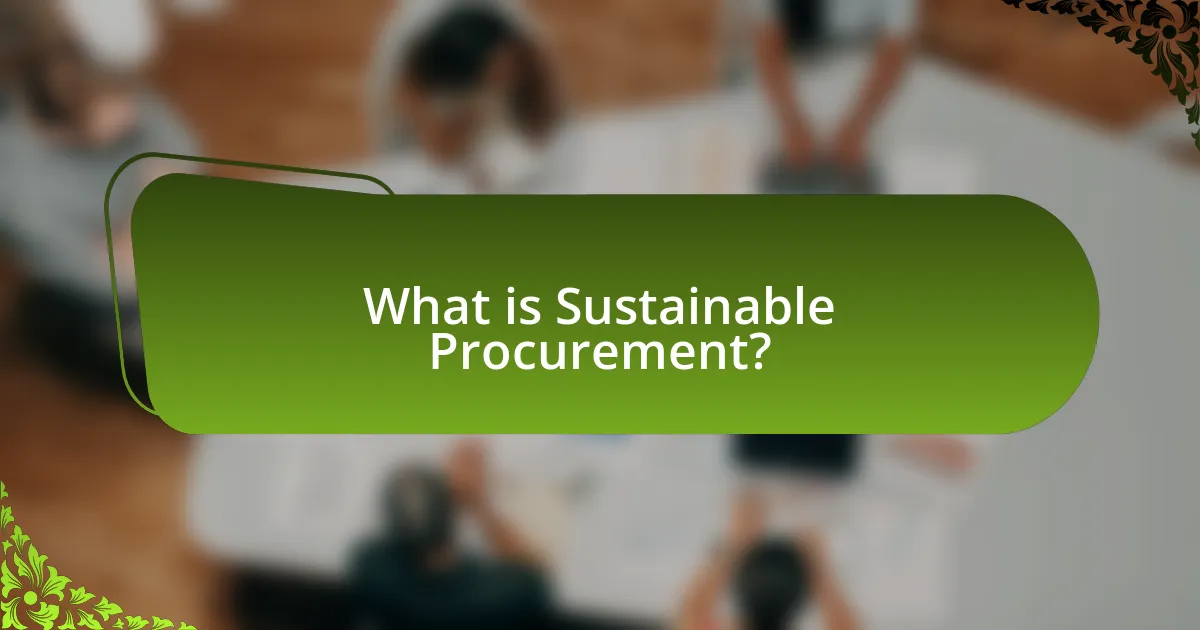
What is Sustainable Procurement?
Sustainable procurement is the process of acquiring goods and services in a way that considers environmental, social, and economic impacts. This approach aims to minimize negative effects on the environment while promoting social equity and economic viability. For instance, organizations may prioritize suppliers who demonstrate sustainable practices, such as using renewable resources or ensuring fair labor conditions. According to the United Nations, sustainable procurement can significantly contribute to achieving the Sustainable Development Goals by fostering responsible consumption and production patterns.
How does Sustainable Procurement differ from traditional procurement?
Sustainable procurement focuses on acquiring goods and services in a way that considers environmental, social, and economic impacts, while traditional procurement primarily emphasizes cost, quality, and delivery. Sustainable procurement integrates criteria such as ethical sourcing, resource efficiency, and lifecycle impacts into decision-making processes, whereas traditional procurement often overlooks these factors in favor of immediate financial savings. For example, a study by the United Nations Environment Programme highlights that sustainable procurement can lead to reduced carbon footprints and enhanced supplier relationships, demonstrating its broader benefits compared to conventional methods.
What are the key principles of Sustainable Procurement?
The key principles of Sustainable Procurement include environmental responsibility, social equity, and economic viability. Environmental responsibility focuses on minimizing negative impacts on the environment by selecting products and services that are eco-friendly and sustainable. Social equity emphasizes fair labor practices and community engagement, ensuring that procurement processes benefit all stakeholders. Economic viability ensures that sustainable choices are also cost-effective, promoting long-term financial health for organizations. These principles guide organizations in making informed purchasing decisions that align with sustainability goals, ultimately contributing to a more sustainable economy and society.
Why is Sustainable Procurement important for businesses?
Sustainable procurement is important for businesses because it enhances long-term profitability while minimizing environmental impact. By integrating sustainability into procurement processes, companies can reduce costs through efficient resource use and waste management. For instance, a study by the Harvard Business Review found that organizations implementing sustainable procurement practices can achieve cost savings of up to 20% by optimizing supply chains and reducing energy consumption. Additionally, sustainable procurement fosters brand loyalty and improves stakeholder relationships, as consumers increasingly prefer companies that demonstrate social responsibility.
What role does technology play in Sustainable Procurement?
Technology plays a crucial role in Sustainable Procurement by enhancing efficiency, transparency, and data-driven decision-making. Advanced software solutions enable organizations to assess suppliers’ sustainability practices, track environmental impact, and optimize resource usage. For instance, tools like procurement analytics platforms provide insights into supply chain emissions, allowing companies to make informed choices that align with sustainability goals. Additionally, technologies such as blockchain improve traceability, ensuring that products meet ethical standards. According to a report by McKinsey, companies leveraging digital tools in procurement can reduce costs by 20-30% while simultaneously improving sustainability outcomes.
How can software solutions enhance Sustainable Procurement practices?
Software solutions can enhance Sustainable Procurement practices by automating data collection and analysis, which improves decision-making and supplier evaluation. These systems enable organizations to track sustainability metrics, such as carbon emissions and resource usage, allowing for informed choices that align with environmental goals. For instance, a study by the World Economic Forum found that companies using procurement software can reduce their supply chain emissions by up to 30% through better supplier selection and performance monitoring. This integration of technology not only streamlines processes but also fosters transparency and accountability in sourcing decisions, ultimately leading to more sustainable outcomes.
What are the challenges of integrating technology into Sustainable Procurement?
Integrating technology into Sustainable Procurement faces several challenges, including data integration, stakeholder resistance, and the need for specialized skills. Data integration issues arise when existing procurement systems do not seamlessly connect with new technologies, leading to inefficiencies and data silos. Stakeholder resistance often stems from a lack of understanding or fear of change, which can hinder the adoption of new tools. Additionally, the requirement for specialized skills to operate and manage advanced technologies can create a skills gap, making it difficult for organizations to fully leverage technological advancements. These challenges are supported by research indicating that 70% of digital transformation initiatives fail due to inadequate change management and skills shortages.

What are the emerging software solutions for Sustainable Procurement?
Emerging software solutions for Sustainable Procurement include platforms that integrate artificial intelligence, blockchain technology, and data analytics to enhance transparency and efficiency in supply chains. For instance, AI-driven tools like EcoVadis assess supplier sustainability performance, while blockchain solutions such as Provenance track product origins and ensure ethical sourcing. Additionally, platforms like SAP Ariba and Coupa offer comprehensive procurement solutions that incorporate sustainability metrics, enabling organizations to evaluate and select suppliers based on environmental and social criteria. These advancements are supported by a growing emphasis on corporate social responsibility and regulatory requirements, driving the adoption of such technologies in procurement practices.
Which software solutions are leading the way in Sustainable Procurement?
Leading software solutions in Sustainable Procurement include SAP Ariba, Coupa, and EcoVadis. SAP Ariba offers comprehensive supply chain management tools that emphasize sustainability metrics, enabling organizations to assess supplier practices effectively. Coupa provides a platform that integrates procurement with sustainability goals, allowing businesses to track and manage their environmental impact. EcoVadis specializes in sustainability ratings, offering insights into supplier performance regarding environmental, social, and governance (ESG) criteria. These solutions are recognized for their ability to enhance transparency and accountability in procurement processes, aligning with the growing demand for sustainable practices in business operations.
What features should businesses look for in Sustainable Procurement software?
Businesses should look for features such as supplier sustainability assessments, lifecycle impact analysis, and compliance tracking in Sustainable Procurement software. Supplier sustainability assessments enable businesses to evaluate the environmental and social practices of their suppliers, ensuring alignment with sustainability goals. Lifecycle impact analysis allows organizations to understand the environmental effects of products from production to disposal, facilitating informed decision-making. Compliance tracking ensures adherence to regulations and standards related to sustainability, reducing risks associated with non-compliance. These features collectively enhance the effectiveness of sustainable procurement strategies, promoting responsible sourcing and minimizing environmental impact.
How do these software solutions measure sustainability performance?
Software solutions measure sustainability performance through various metrics and analytics that assess environmental, social, and governance (ESG) factors. These metrics often include carbon footprint calculations, resource consumption tracking, waste management assessments, and supply chain transparency evaluations. For instance, platforms may utilize data analytics to quantify emissions reductions or resource savings, providing organizations with actionable insights to improve their sustainability practices. Additionally, many software solutions integrate industry standards and benchmarks, allowing companies to compare their performance against peers and identify areas for improvement.
What are the benefits of using software solutions in Sustainable Procurement?
Software solutions in Sustainable Procurement enhance efficiency, transparency, and compliance. These tools streamline processes by automating tasks such as supplier evaluation and contract management, which reduces manual errors and saves time. Additionally, software solutions provide real-time data analytics, enabling organizations to track sustainability metrics and make informed decisions. For instance, a study by the Harvard Business Review found that companies using procurement software reported a 20% increase in supplier compliance with sustainability standards. This demonstrates that software not only facilitates better procurement practices but also fosters accountability and promotes sustainable sourcing.
How do software solutions improve supplier collaboration?
Software solutions improve supplier collaboration by facilitating real-time communication and data sharing between organizations and their suppliers. These platforms enable seamless integration of supply chain processes, allowing for better visibility into inventory levels, order statuses, and delivery schedules. For instance, a study by McKinsey & Company found that companies utilizing digital supply chain solutions can achieve up to a 20% reduction in procurement costs and a 30% improvement in supplier performance metrics. This enhanced collaboration leads to stronger relationships, increased trust, and ultimately, more efficient and sustainable procurement practices.
What cost savings can be achieved through Sustainable Procurement software?
Sustainable Procurement software can achieve significant cost savings by optimizing supply chain management and reducing waste. By analyzing supplier performance and sustainability metrics, organizations can identify cost-effective suppliers who align with sustainability goals, leading to lower procurement costs. For instance, a study by the Harvard Business Review found that companies implementing sustainable procurement practices can reduce costs by up to 20% through improved supplier negotiations and reduced material waste. Additionally, these software solutions often streamline processes, resulting in lower operational costs and enhanced efficiency.

How can businesses effectively implement Sustainable Procurement software?
Businesses can effectively implement Sustainable Procurement software by first conducting a thorough needs assessment to identify specific sustainability goals and requirements. This assessment allows organizations to select software that aligns with their sustainability objectives, such as reducing carbon footprints or enhancing supplier transparency.
Next, businesses should engage stakeholders across departments to ensure buy-in and gather insights on procurement processes. Training sessions for employees on how to use the software effectively are crucial for maximizing its potential.
Additionally, integrating the software with existing systems, such as ERP or supply chain management tools, enhances data flow and usability. Regularly monitoring and evaluating the software’s performance against sustainability metrics ensures that the implementation remains aligned with the organization’s goals.
Research indicates that companies that adopt a structured approach to implementing such software can achieve up to a 20% reduction in procurement costs while improving sustainability outcomes (Source: “Sustainable Procurement: A Global Perspective,” by the United Nations Environment Programme).
What steps should businesses take to adopt Sustainable Procurement software?
Businesses should take the following steps to adopt Sustainable Procurement software: first, assess their current procurement processes to identify areas for improvement in sustainability. Next, they should research and select software solutions that align with their sustainability goals, ensuring the software offers features like supplier evaluation, lifecycle analysis, and compliance tracking. After selecting the software, businesses must train their procurement teams on its functionalities and integrate it with existing systems for seamless operation. Finally, they should continuously monitor and evaluate the software’s impact on sustainability metrics, making adjustments as necessary to enhance performance. This structured approach ensures that businesses effectively implement Sustainable Procurement software, leading to improved sustainability outcomes.
How can organizations ensure successful training and adoption of the software?
Organizations can ensure successful training and adoption of software by implementing a structured training program that includes hands-on sessions, user-friendly documentation, and ongoing support. A structured approach allows employees to engage with the software in a practical context, which enhances retention and usability. Research indicates that organizations that provide comprehensive training see a 30% increase in software adoption rates, as employees feel more confident and competent in using the tools provided. Additionally, involving key stakeholders in the training process fosters a sense of ownership and encourages a culture of continuous learning, further solidifying the software’s integration into daily operations.
What metrics should be used to evaluate the success of the software implementation?
Key metrics to evaluate the success of software implementation include user adoption rates, system performance, return on investment (ROI), and user satisfaction scores. User adoption rates measure how many users actively engage with the software, indicating its acceptance and usability. System performance metrics, such as uptime and response time, assess the software’s reliability and efficiency. ROI quantifies the financial benefits gained from the software relative to its costs, providing a clear picture of its economic impact. User satisfaction scores, often gathered through surveys, reflect the overall experience and effectiveness of the software from the end-user perspective. These metrics collectively provide a comprehensive evaluation of software implementation success.
What are the common pitfalls to avoid when implementing Sustainable Procurement software?
Common pitfalls to avoid when implementing Sustainable Procurement software include inadequate stakeholder engagement, lack of clear objectives, insufficient training, and neglecting data integration. Inadequate stakeholder engagement can lead to resistance and misalignment with organizational goals, as stakeholders may not understand the benefits of sustainable practices. Lack of clear objectives results in ambiguous implementation processes, making it difficult to measure success. Insufficient training can hinder user adoption, as employees may struggle to utilize the software effectively. Finally, neglecting data integration can create silos, preventing comprehensive analysis and reporting, which are essential for informed decision-making. Addressing these pitfalls is crucial for successful implementation and maximizing the benefits of Sustainable Procurement software.
How can businesses mitigate risks associated with software adoption?
Businesses can mitigate risks associated with software adoption by conducting thorough assessments of software solutions before implementation. This includes evaluating vendor reliability, understanding software compatibility with existing systems, and assessing user needs through stakeholder engagement. Research indicates that 70% of software projects fail due to inadequate requirements gathering and stakeholder involvement, highlighting the importance of these assessments. Additionally, implementing a phased rollout allows businesses to identify issues early and adjust strategies accordingly, further reducing potential disruptions.
What strategies can help overcome resistance to change within organizations?
To overcome resistance to change within organizations, effective strategies include clear communication, employee involvement, and providing training. Clear communication ensures that all stakeholders understand the reasons for the change and its benefits, which can reduce uncertainty and anxiety. Employee involvement in the change process fosters a sense of ownership and commitment, making individuals more likely to support the transition. Providing training equips employees with the necessary skills and knowledge to adapt to new systems or processes, thereby increasing confidence and reducing resistance. Research indicates that organizations that actively engage employees in change initiatives experience higher success rates, as seen in a study by Kotter International, which found that 70% of change initiatives fail due to employee resistance.
What best practices should businesses follow for Sustainable Procurement success?
Businesses should adopt a comprehensive approach to Sustainable Procurement by integrating environmental, social, and economic considerations into their purchasing decisions. This includes establishing clear sustainability criteria for suppliers, conducting regular assessments of supplier practices, and prioritizing local sourcing to reduce carbon footprints. Additionally, businesses should invest in training procurement teams on sustainability principles and leverage technology, such as procurement software, to track and analyze sustainability metrics effectively. Research indicates that companies implementing sustainable procurement practices can reduce costs by up to 20% while enhancing brand reputation and customer loyalty.
How can continuous improvement be integrated into Sustainable Procurement processes?
Continuous improvement can be integrated into Sustainable Procurement processes by implementing a systematic approach that includes regular assessments, stakeholder feedback, and performance metrics. This integration allows organizations to identify inefficiencies and areas for enhancement, ensuring that procurement practices align with sustainability goals. For instance, utilizing software solutions that track supplier performance and sustainability metrics can provide data-driven insights, enabling organizations to make informed decisions and foster ongoing improvements. Research indicates that companies employing continuous improvement methodologies in procurement can achieve up to a 20% reduction in costs while enhancing their sustainability outcomes, demonstrating the effectiveness of this approach.
What role does stakeholder engagement play in Sustainable Procurement initiatives?
Stakeholder engagement is crucial in Sustainable Procurement initiatives as it ensures that diverse perspectives and needs are considered, leading to more effective and inclusive decision-making. Engaging stakeholders, including suppliers, customers, and community members, fosters collaboration and transparency, which are essential for identifying sustainability goals and challenges. Research indicates that organizations with strong stakeholder engagement in their procurement processes are more likely to achieve their sustainability objectives, as they can leverage collective insights and resources. For instance, a study by the Harvard Business Review found that companies actively involving stakeholders in their sustainability strategies reported a 30% increase in successful project outcomes.
